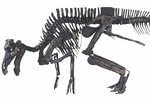Paleontology and geologyThe Precambrian: A thick sequence of Late Precambrian sedimentary rocks indicates that the western part of Montana was covered by a warm, shallow sea. These rocks contain the oldest evidence for life in Montana, including stromatolites and trace fossils left by animals crawling along the sea floor.
The Paleozoic: Shallow marine waters continued to cover most of Montana through the early part of the Paleozoic (Cambrian), supporting a great diversity of algae, invertebrates, and some of the earliest vertebrates. Following the retreat of this sea, high rates of erosion removed most of the Silurian and Early Devonian rocks from the state. The seas returned in the Late Devonian, inundating nearly all of Montana. Crinoids, sponges, brachiopods, molluscs, conodonts, and fish thrived in the warm waters. Marine conditions persisted into the Carboniferous, and the seas were home to a remarkable diversity of cartilaginous fishes. During the Late Carboniferous (Pennsylvanian), regional uplift created highlands in the north-northwestern part of the state, and the shallow seas again retreated. Erosion of these uplifted areas continued into the Permian. The end of the Paleozoic is represented only by a thin blanket of marine sediments in the southeast that were deposited during a brief incursion of a shallow sea.
The Mesozoic: A hot, arid landscape stretched across Montana through most of the Triassic. The only fossils present are marine, indicating two brief incursions of the sea. During the Jurassic, warm, tropical seas returned to Montana, gradually retreating as eroding highlands in the west shed sediment to the east and northwest. Montana's oldest dinosaurs roamed among the vegetation of ferns, ginkgos, cycads, and conifers. Mountain building and episodes of violent volcanism mark the Cretaceous in western Montana. Terrestrial ecosystems supported a wide diversity of plants and animals, including numerous dinosaurs.
The Cenozoic: The sea retreated from Montana for the final time during the Tertiary. A major episode of tectonic activity folded and faulted the crust, creating several mountain ranges and elevating the state by thousands of meters. Dry climatic conditions alternated with wet, tropical conditions throughout this period. Large titanotheres, dogs, and other mammals roamed the landscape. The climate became increasingly wetter and cooler through the Quaternary. Glaciers expanded in the mountains of northwest Montana and the Yellowstone region, carving out mountain peaks and flattening the northern third of the state. Mammoths, dire wolves, and musk ox roamed the regions that were ice-free. |

